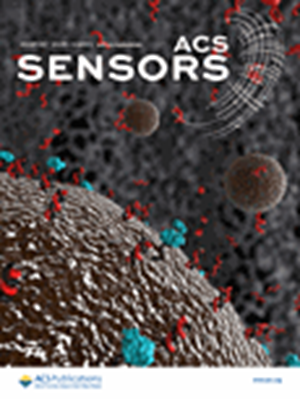利用金属配合物进行基于微秒寿命的氯化物传感
IF 9.1
1区 化学
Q1 CHEMISTRY, ANALYTICAL
引用次数: 0
摘要
氯离子是细胞中含量最多的阴离子,在维持细胞内稳态中起着重要作用。然而,目前的氯化物指示剂在其发射特性上具有固有的敏感性,例如易受pH变化或发射寿命短。这些限制限制了它们在水介质和成像中的应用。本文采用含吡啶的过渡金属配合物作为氯化物的识别单元,研究了其磷光发射特性。合成了铱(III)配合物1作为氯敏发光团。共轭设计也允许定制所需的应用。在不同的生理环境中,配合物1对氯离子具有高的敏感性和选择性,而不受pH波动和离子强度的影响。此外,复合体1具有微秒级的发射寿命。配合物1的氯化物感应能力可以通过发光强度和长磷光寿命来测量,为氯化物成像提供了另一种潜在途径。类似物1b成功地应用于细胞环境中Cl -的成像,并在活细胞和固定细胞中显示剂量依赖性反应。本文章由计算机程序翻译,如有差异,请以英文原文为准。

Leveraging Metal Complexes for Microsecond Lifetime-Based Chloride Sensing
Chloride is the most abundant anion in cells and plays many critical roles in maintaining cellular homeostasis. However, current chloride indicators are rare with inherent sensitivity in their emission properties, such as vulnerability to pH changes or short emission lifetimes. These limitations restrict their application in aqueous media and imaging. In this work, we employed a transition-metal complex bearing pyridinium as a recognition unit for chloride and studied the phosphorescence emission properties. Iridium(III) complex 1 was synthesized as an alternative chloride-sensitive luminophore. The conjugable design also allows customization for the desired applications. Complex 1 exhibited high sensitivity and selectivity in chloride sensing across different physiological environments, regardless of pH fluctuation and ionic strength. Additionally, complex 1 featured a microsecond emission lifetime. The chloride sensing ability of complex 1 can be measured through both the luminescence intensity and long-lived phosphorescent lifetime, providing an alternative potential route for chloride imaging. The analogue 1b was successfully applied in the imaging of Cl– in cellular environments and showed dose-dependent responses in both live and fixed cells.
求助全文
通过发布文献求助,成功后即可免费获取论文全文。
去求助
来源期刊

ACS Sensors
Chemical Engineering-Bioengineering
CiteScore
14.50
自引率
3.40%
发文量
372
期刊介绍:
ACS Sensors is a peer-reviewed research journal that focuses on the dissemination of new and original knowledge in the field of sensor science, particularly those that selectively sense chemical or biological species or processes. The journal covers a broad range of topics, including but not limited to biosensors, chemical sensors, gas sensors, intracellular sensors, single molecule sensors, cell chips, and microfluidic devices. It aims to publish articles that address conceptual advances in sensing technology applicable to various types of analytes or application papers that report on the use of existing sensing concepts in new ways or for new analytes.
 求助内容:
求助内容: 应助结果提醒方式:
应助结果提醒方式:


